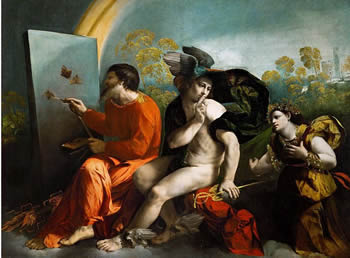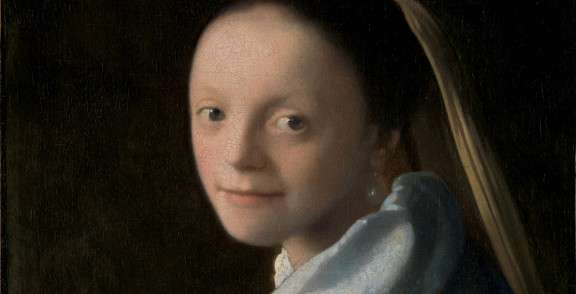Willem van Berkel - "Jupiter, Venus and Mercury"
"In 1716 a now-lost history painting from the beginnings of Vermeer's career, called "Jupiter, Venus and Mercury, by J. ver Meer," was auctioned from the estate of Delft patrician Willem van Berckel (c. 1620–1686). The collection had been formed earlier in the century by Gerard van Berckel, a one-time burgomaster of the city of Delft. "This mythological scene, presumably in the possession of the distinguished Delft family for a long time, may be considered evidence of the interest in Vermeer's work in the upper echelons of Delft society."1
Initially, John Michael Montias held that with "Diana and her Companions represented "Vermeer's only foray into mythology since "Jupiter, Venus and Mercury do not appear jointly in any know subject drawn from mythology. Perhaps the auctioneer mistook the female figure for Venus, when it actually represented Virtue or Psyche. Dosso Dossi's painting of Jupiter, Mercury and Virtue (shown as a female figure) is conserved in Vienna. Raphael is known to have made a drawing of Mercury introducing Psyche to Jupiter."2
However, Michiel C. Plomp revealed "a drawing by [Leonaert] Bramer after a painting by Jacob Jordaens, the subject of which is taken from the legend of Psyche in Apuleius's Golden Ass. It shows a jealous Venus complaining to Jupiter, in Mercury's presence, about Psyche's charms. This unpublished drawing...was once part of the album of about 110 drawings made by Bramer after paintings that belonged to Delft collectors in 1652–1653. It is quite possible… that Vermeer had seen the Jordaens painting not long before he painted his own version of the subject (presumably before 1656, the date of The Procuress, his first genre painting). The Jordaens composition would have appealed to his own interest in women attending, or deferring to, men (as in Christ in the House of Martha and Mary)."3
The young and ambitious Vermeer may have painted this mythological scene in order to cater to the classical tastes of the Dutch court in the rich and nearby The Hague. The painting appeared in the Delft auction on March 24, 1761.

† FOOTNOTES †
- Arthur K. Wheelock Jr., in exh. cat. Johannes Vermeer, eds. Arthur K. Wheelock Jr. and Ben Broos, London and New Haven: Yale University Press, 1995, 55.
- John Michael Montias, Vermeer and His Milieu: A Web of Social History
, Princeton, NJ: Princeton University Press, 1989, 140.
- John Michael Montias, "A Postscript on Vermeer and His Milieu," Mercury, 1991. http://www.kunstpedia.com/articles/a-postscript-on-vermeer-and-his-milieu.html?page=3




 or anything else that isn't working as it should be, I'd love to hear it! Please write me at:
or anything else that isn't working as it should be, I'd love to hear it! Please write me at: